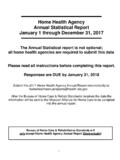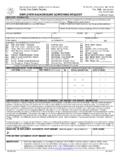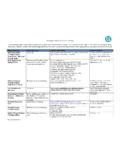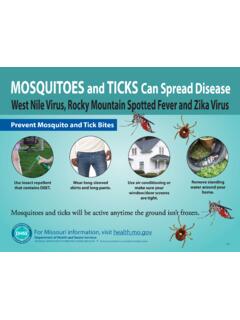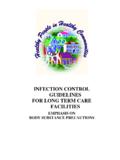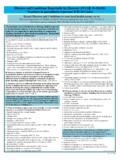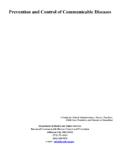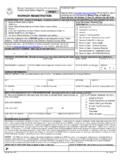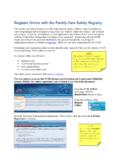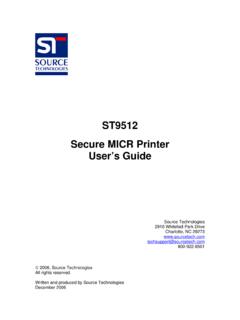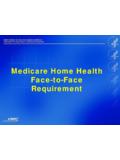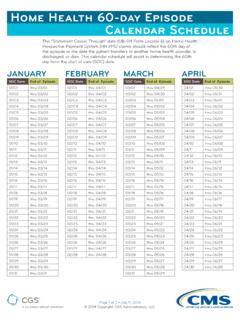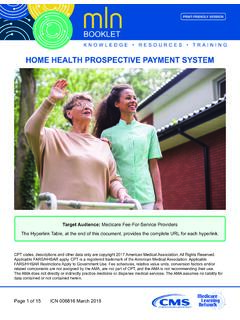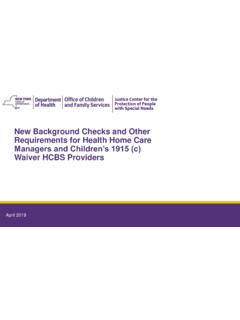Transcription of OASIS-D Handouts [Read-Only] - Missouri
1 11/06/20181 OASIS-D UpdatePresented by:Suzi Hamlet RN, MSN, COS-C, oasis Educational Coordinator Robin Swarnes RN, BSN, COS-C1 OASIS-D UpdateLEARNING OBJECTIVES Identify the changes to Outcome and Assessment Information Set ( oasis ) resulting from the Improving Medicare Post-Acute Care Transformation (IMPACT) Act of 2014 Describe the major changes from oasis -C2 to OASIS-D Understand oasis M-item coding instructions to accurately code new and revised oasis items Identify available resources for implementing oasis -D211/06/20182 Why OASIS-D ? Improving Medicare Post-Acute Care Transformation Act of 2014 Bipartisan bill signed into law by President Obama October 6, 2014 Requires Post-Acute Care (PAC) providers to report standardizedpatient assessment data and quality measure data Long Term Care Hospitals (LTCH) Skilled Nursing Facilities (SNF) Inpatient Rehabilitative Facility (IRF) Home Health Agencies (HHA) Hospices PAC Medicare spending $ ACT OF 2014 IMPACT ACT of 2014 Driving Forces4 PURPOSE.
2 Improve Medicare beneficiary outcomes Provide access to longitudinal data to facilitate coordinated care Enable comparable data and quality across PAC settings Improve hospital discharge planning Research Why the attention on Post-Acute Care? Escalating cost associated with PAC Lack of data standards across PAC Goal of establishing payment rates according to the individual characteristics of the patient, not the care settingPost Acute Care?11/06/20183 Why Standardization in PAC?5 Inpatient RehabFacilitiesSkilled Nursing FacilitiesHome Health AgenciesLong Term Care HospitalsIRF-PAIMDSOASISLCDSE atingEatingEatingEatingWhy Standardization in PAC?
3 6 Inpatient RehabFacilitiesSkilled Nursing FacilitiesHome Health AgenciesLong Term Care HospitalsIRF-PAIMDSOASISLCDSE atingEatingEatingEating11/06/20184 Standardized Patient Assessment Data Elements (SPADEs)7 OASISLCDSMDSIRF-PAISPADEs: Questions and response options that are identical in all four PAC assessment instruments Identical standards and definitions apply The move toward standardized assessment data elements facilitates cross-setting data collection, quality measurement, outcome comparison, and interoperable data exchangeWhy is oasis Being Updated Now?
4 8 IMPACT Act/StandardizationCross-Setting AlignmentStandardized Data CollectionUpdates and CorrectionsNew Standardized Items Section J: J1800 & J1900 Section GG: GG0100, GG0110, GG0130, & GG0170 Alignment in content of items that support cross-setting measures Drug Regimen Review Pressure Ulcers Active Diagnosis Height & WeightReduction of burden Quality measure changes Survey and certificationGeneral updatesCorrections made as necessary11/06/20185 New items are added Different time point versions of some items Removal of items Revision of some items Updated Skip Patterns9 Chapter 3, two new sections of standard guidance added.
5 Section J Health Conditions Section GG Functional Abilities and Goals Chapter 4, Illustrative Examples are retired Removal of many items and their corresponding guidance Revisions to existing Guidance for some oasis items to update or clarify information Appendix F - sample reports are not included in this version. Users may refer to the Casper Reporting User Manual, Section 6, oasis Quality Improvement Reports, located at: Guidance Manual Changes11 Guidance Manual Changes for 33 ItemsM0080, M0090, M0102, M1021, M1023, M1046, M1056, M1060, M1307, M1332, M1334, M1342, M1610, M1730, M1800, M1810, M1820, M1830, M1840, M1845, M1850, M1860, M1870, M1910, M2001, M2003, M2005, M2010, M2016, M2020, M2030, M2301, M2401 OASIS-D ChangesEffective January 1, 2019 For these 33 items, the Guidance Manual has been updated in one or more of the following sections.
6 Item Intent Time Points Collected Response Specific Instructions Examples Data Sources and ResourcesOASIS-D New Items12 Section J: Health Conditions (Falls) J1800: Any Falls Since SOC/ROC J1900: Number of Falls Since SOC/ROCS ection GG: Functional Abilities and Goals GG0100: Prior Functioning: Everyday Activities GG0110: Prior Device Use GG0130: Self-Care GG0170: Mobility11/06/20187 OASIS-D Revised Items13M1028M1306M1311M1322M1324M2102M23 10 Active DiagnosesUnhealed Pressure Ulcer/Injury at Stage 2 or Higher?Current Number of Unhealed Pressure Ulcers/Injuries at Each StageCurrent Number of Stage 1 Pressure InjuriesStage of Most Problematic Unhealed Pressure Ulcer/Injury that is Stageable Types and Sources of AssistanceReason for Emergent CareOASIS-D Revised ItemsThe 7 revised assessment items may have changes in one or more of the following areas.
7 14 Time point versionsItem textResponse option(s)Use of the DASH (-) as a valid responseSkip patterns11/06/20188 Skip Pattern Changes 15M1000Go To M1021 (M1017 item removed)M1051M1306M1311M1340M1610M2001M2 410M2420M1501 and M1230 items removed, New Go To PatternSOC/ROC/F-up Go To M1322, Discharge Go To M1324 New Time Point Versions, with specific Go To PatternsM1350 item removed, New Go To PatternM1615 and M1620 items removed, No Go To Pattern neededM2040 item removed, New Go To PatternM2430 and M0906 items removed, No Go To Pattern neededM2430 item removed, No Go To Pattern neededOASIS Items Removed16 oasis Items were removed if they were not used to support.
8 HH QRP measures hh prospective payment system (PPS) Survey process for Medicare certification HH Value-Based Purchasing (VBP) demonstration measures Critical risk-adjustment factors Conditions of Participation 28 Items Removed M0903, M1011, M1017, M1018, M1025, M1034, M1036, M1210, M1220, M1230, M1240, M1300, M1302, M1313, M1320, M1350, M1410, M1510, M1511, M1615, M1750, M1880, M1890, M1900, M2040, M2110, M2250, M243011/06/20189 Updated One Clinician Rule Although one clinician must take responsibility for the comprehensive assessment, collaboration with the patient, caregivers, and other health care personnel, including the physician, pharmacist.
9 And/or other agency staff is appropriate. For items requiring patient assessment, the collaborating healthcare providers must have had direct contact with the patient. Agencies may have the comprehensive assessment completed by one clinician. If collaboration with other health care personnel and/or agency staff is utilized, the agency is responsible for establishing policies and practices related to collaborative efforts, including how assessment information from multiple clinicians will be documented within the clinical record, ensuring compliance with applicable requirements, and accepted standards of practice.
10 When collaboration is utilized, the M0090 Date assessment completed should reflect the last date the assessing clinician gathered or received any input used to complete the comprehensive assessment, including the oasis items. When used, collaboration must occur within the appropriate timeframe and consistent with data collection guidance. Any exception to this general convention concerning collaboration is identified in item-specific Assessment Completion At the start of care time point, the comprehensive assessment should be completed within five days after the start of care date.
